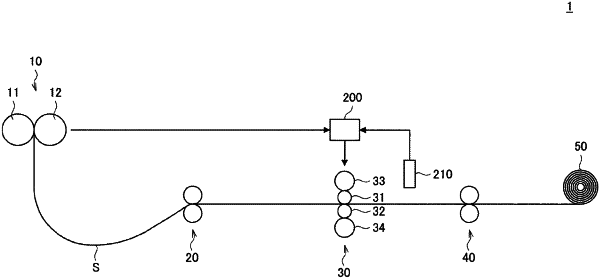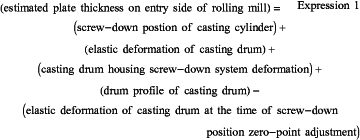| CPC B21B 1/04 (2013.01) [B21B 37/58 (2013.01); B22D 11/06 (2013.01); B22D 11/12 (2013.01); B21B 1/00 (2013.01); B21B 37/66 (2013.01); B21B 2001/028 (2013.01)] | 6 Claims |

|
1. A slab manufacturing method for manufacturing a slab using a twin-drum type continuous casting device configured to cast a slab by solidifying a molten metal using a pair of rotating casting drums; and a rolling mill configured to roll the cast slab using a pair of work rolls, comprising:
calculating estimated plate thicknesses at both of end portions of the slab in a width direction from Expression 1:
 using casting drum housing screw-down system deformation characteristics acquired prior to the start of slab casting indicating deformation characteristics of housings configured to support the casting drums and deformation characteristics of a screw-down system configured to screw down each of the casting drums;
calculating an entry-side wedge ratio indicating a ratio of an entry-side wedge which is a difference between plate thicknesses at both of the end portions on an entry side of the rolling mill to an entry-side plate thickness of the slab on the basis of the estimated plate thicknesses calculated from the Expression 1;
calculating an exit-side wedge ratio indicating a ratio of an exit-side wedge which is a difference between plate thicknesses at both of the end portions on an exit side of the rolling mill to an exit-side plate thickness of the slab; and
adjusting a screw-down position of the rolling mill so that a difference between the entry-side wedge ratio and the exit-side wedge ratio is within a prescribed range.
|